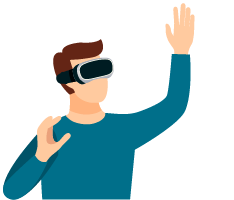In some ways, virtual reality (VR) still feels very futuristic. Television and movies led us to believe that VR would be all encompassing, surrounding us in a complete fantasy world whenever we wanted. In reality, when it comes to VR, the future is here. It just doesn’t look like what we thought it would. VR applications touch many industries and one industry most people wouldn’t realize offhand is the e-learning industry.
With it, VR brings the power of presence. Because our brains treat VR like a real experience, e-learning content that takes advantage of VR techniques has the potential to be extremely engaging, amongst a slew of other benefits.
1. Engagement

When it comes to fostering engagement during e-learning, VR is hard to beat. VR can captivate an audience, capturing students’ undivided attention and allowing them to learn in an immersive way. A 2016 study in China looked at VR’s effectiveness as a learning tool. The study found that the passing rate for students that engaged with the e-learning material via VR was 93%. The students that did not utilize VR techniques to study the exact same material only had a pass rate of 73%.
2. Experiential & Embodied Learning

VR can offer students hands-on practice using their own bodies. Imagine during a training being able to interact with different objects in a scene and how much more tangible that experience would feel compared to reading about it or watching someone else doing it? This could be something as small as opening a door or a more in-depth equipment training. Research suggests that when we use our hands or move, we’re able to remember what we learned better.
3. State-Dependent Retention
Research shows that you can recall information better if you’re in the same environment you encoded that information in. VR provides a safe opportunity to learn in an environment similar to one where students may be tested one day, such as a fireman training to learn how to save someone from a burning building.
4. Deliberate Practice

VR in e-learning thrives on mistakes. Why? When you utilize VR in e-learning, students can practice and get feedback immediately after making a mistake. Students will have the opportunity to fail and test out new solutions in a risk-free setting. This is especially ideal for job training that requires someone to react quickly in stressful situations. VR can help identify performance gaps when the stakes are much lower and can provide valuable online training experiences before entering real-life situations.
5. Visualization

Visualization helps students learn. Instead of staring at a page in a book or hearing a lecturer discuss their experiences, imagine being able to have those experiences yourself? While VR is not a replacement for true reality, it can provide visualized learning experiences. For example, during a VR e-learning opportunity, you may be able to move your head and as you do see what changes around you, just as you would in real life. Visualization can lead to a greater understanding of the material and can help with retention.
6. Storytelling & Empathy With Characters
A famous Stanford study from 1969 found that students who were tasked with memorizing words retained six to seven times more words when incorporating them into a story compared to the students who simply tried to memorize a list. Storytelling has always had an impact on humans, especially when we can empathize with characters. VR can incorporate both storytelling and empathetic characters into e-learning. The potential to impersonate a character yourself while interacting with other characters in the story can enhance the feeling of being immersed in the story, can make the student more invested in the characters, and can increase retention rates.
7. Analysis Abilities

From a creator standpoint, VR can give the opportunity to have more data and insight into the learning experience. Techniques like head and eye tracking, head and body tracking, and heatmaps can give creators insight into how they can improve the learning experience for students. Creators can receive analytics that illustrate the time it takes students to complete tasks in the virtual world or can alert students of any mistakes they make. This high-level access to such valuable data means that VR techniques in e-learning will keep getting better and better.









